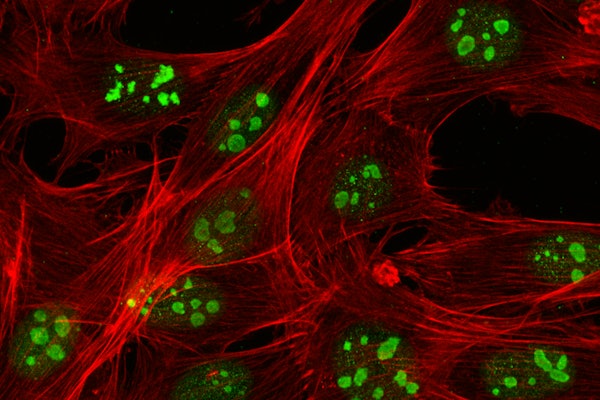2022-09-20 ワシントン大学セントルイス
Image showing nucleolar bodies, with F-actin (red) and nucleolin (green), in human breast cancer cells (MDA-MB-231) cultured on soft (0.5 kPa) hydrogels. This study demonstrates changes in nucleolar composition in cells due to their tumorigenic potential and environmental cues. The image was acquired on a laser-scanning confocal microscope (ZEISS LSM 880) using a 63X objective. (Image: Florence Flick Jaecker, Department of Mechanical Engineering & Materials Science, Washington University in St. Louis)
ワシントン大学セントルイス・マッケルビー工学部の機械工学および材料科学の准教授であるAmit Pathakが率いる細胞メカノバイオロジー研究所は、最近、これらの機械的および空間的合図が、内部に存在する核小体として知られるクラスター化された物体を変化させる可能性があることを発見しました。
この研究の結果は、細胞上および細胞内の力に焦点を当てたジャーナルMolecular Biology of the Cellの特別号に 9 月 7 日に掲載されました。
<関連情報>
- https://source.wustl.edu/2022/09/washu-researchers-observe-cancer-like-nucleoli-in-healthy-cells/
- https://www.molbiolcell.org/doi/10.1091/mbc.E22-02-0070
上皮細胞集団の核小体は、腫瘍形成、空間的、機械的な手がかりに反応する Nucleoli in epithelial cell collectives respond to tumorigenic, spatial, and mechanical cues
Florence Flick Jaecker,José A. Almeida,Carly M. Krull and Amit Pathak
Molecular Biology of the Cell Published:7 Sep 2022
DOI:https://doi.org/10.1091/mbc.E22-02-0070
Abstract
Cancer cells are known to have larger nucleoli, consistent with their higher transcriptional and translational demands. Meanwhile, on stiff extracellular matrix, normal epithelial cells can exhibit genomic and proteomic mechanoactivation toward tumorigenic transformations, such as epithelial–mesenchymal transition and enhanced migration. However, while nucleolar bodies regulate the protein synthesis required for mechanosensation, it remains unknown whether mechanical and spatial extracellular cues can in turn alter nucleoli. Here, we culture mammary epithelial cell sheets on matrices of varying stiffness and show that cancer cells have more nucleoli, with nucleoli occupying larger areas compared with normal cells. By contrast, within normal epithelial sheets, stiffer matrices and leader positioning of cells induce larger nucleolar areas and more nucleolar bodies over time. The observed leader–follower nucleolar differences stem from distinct rates of cell cycle progression. In the nucleoplasm, leader cells on stiffer matrices exhibit higher heterochromatin marker expression and DNA compaction around nucleolar bodies. Overall, our findings advance the emerging framework of cellular mechanobiology in which mechanical cues from the extracellular matrix transmit into the nucleoplasm to alter nucleolar composition, potentially resulting in mechanosensitive ribosomal biogenesis. Ultimately, this proposed mechanosensitivity of nucleoli and associated protein synthesis could have wide implications in disease, development, and regeneration.



